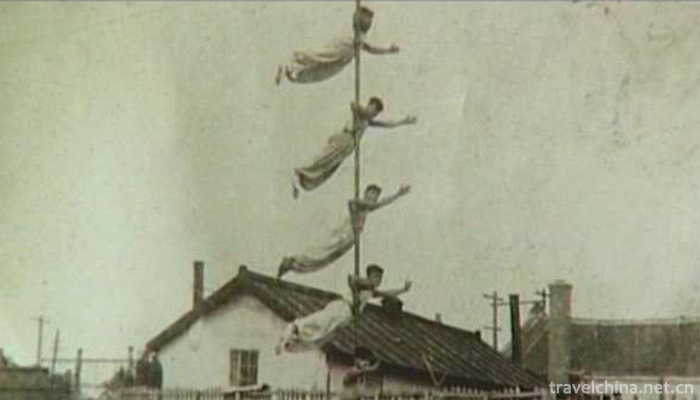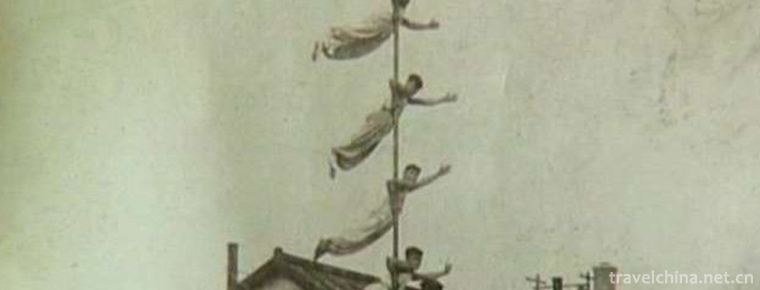Ningjin Acrobatics
Ningjin Acrobatics
Ningjin acrobatics is one of the traditional folk acrobatics in Shandong Province. With its long history of development, extensive mass base, profound cultural heritage and exquisite performing skills, it has exerted a great influence on the development of Chinese acrobatics. So far, there is still a saying that "there is no Ningjin people, it is difficult to become an acrobatics troupe".
On June 7, 2008, Ningjin acrobatics declared by Ningjin County of Shandong Province was listed in the second batch of national intangible cultural heritage list with the approval of the State Council. Heritage serial number: 822 VI-50.
historical origin
Ningjin County belongs to ancient Jizhou. Ningjin acrobatics has a long history and has a long history. According to textual research, "Han Shu", "Shi Ji", "Shu Yi Ji" and the annals of Ningjin County in the Qing Dynasty, all recorded Chiyou Jiao Dai Opera in Jizhou, "Chiyou's head has a role, fighting with Huangdi, with Jiao Dai Ren, Jizhou today is Chiyou Opera". Ren Fang, a writer of the Southern Dynasty, wrote in A Tale of Different Articles that "Jizhou is happy and famous Chiyou Opera". Ningjin acrobatics originates from the eight villages in the north and south of Ningjin County, which are centered on Huangjia Town. It comes from the folk and comes from life. It is the crystallization of Ningjin people's courage to be the first, courage to explore and wisdom. With the opening of the Beijing-Hangzhou Grand Canal, Ningjin, which is facing the canal in the west, is the first place to win the atmosphere. Folk acrobats go south and North and spread all over the country, which makes Ningjin acrobatics run through the north and south, and has an open mind and outlook. After the Tang Dynasty, Ningjin acrobatics was widely spread among the people. In the period of Ming Dynasty, Jingtai, the first ancient acrobatics trade association in Chinese history, Huangjiazhen Acrobatics Association, came into being. The meeting period began in early September of the lunar calendar and lasted for one month, which was historically called "September Meeting". The phrase "not to catch the September meeting, not to be a businessman" is well known in acrobatics circles. During the ancient meeting, acrobats from all over the country gathered in Huangjia Town one after another to show their abilities, discuss skills, collect apprentices, group classes, and buy and sell props. Therefore, there is the saying that there are hundreds of kinds of arts, which are called thousands of sets.
In the Qing Dynasty, acrobatics activities in Ningjin became more prosperous, with the emergence of performing groups that were semi-agricultural, semi-artistic or made a living by selling art, and two major factions, namely, the North and South Bazhai, were gradually formed. During the reign of Guangxu in Qing Dynasty, Empress Dowager Cixi put on 72 imperial assemblies in Beijing, and Zhang, an artist from Licun, a wild boar in Ningjin County, performed the stunt of "crossing the city gate with a bamboo pole", ranking first among the imperial assemblies, and became a well-known figure in the Forbidden City and the acrobatics circles at that time. In the 1920s and 1930s, acrobats from the eight villages in the north and South came out of their homes, countries and rivers and lakes one after another. At that time, the popular saying "Ningwu two counties, chicken feathers turn into eggs, go south and rush north without entanglement" was a true portrayal of the life of acrobats drifting away from home by selling their skills. They traveled to Hong Kong, India, Myanmar, Nepal, Japan, Mongolia, the Soviet Union, and Western European countries, forming a large-scale convergence and exchange of Chinese acrobatics and world culture and art. At home, their footprints are all over the Yangtze River, north and south of the Yangtze River, and "no Ningjin people can hardly become an acrobatics class", so they got their name and spread widely. "Ninety-nine, down to go, if you play, everyone has one hand", is a strong foundation of Ningjin acrobatics, a large number of participants, a wide range of coverage, far-reaching historical portrayal. After liberation, Ningjin acrobatics ushered in an unprecedented period of development and prosperity. From 1956 to 1958, on the basis of the past acrobatics team, Ningjin County acrobatics group 1,2 and 3 were formed one after another. The acrobatics troupe's performances gradually shifted from urban and rural areas to large and medium-sized cities, and the way and method of sending in and inviting in were adopted. The students'strengths and weaknesses were supplemented to improve their own skills. Tianjin acrobatics ushered in the development climax again and again.
artistic characteristics
Ningjin acrobatics is simple, rough, rigid and flexible, highlighting the five artistic features of "surprise, danger, wonder, beauty and novelty", and has high aesthetic value, ornamental value and cultural value. Ningjin acrobatics has four categories: performance, magic, circus and animal training. There are more than 60 performances in the performance category. More than ten kinds of programs, such as the ancient Zhongbian, the flexible technique of holding flowers and rolling lights, the flying man in the air, the climbing pole, the steel wire high car, the piling arhat, the steel wire walking, the pedaling technique, the terrace, the opposite mouth holding flowers and so on, have been well received by the audiences and the professionals at home and abroad for many times.
Inheritance and Protection
After the founding of New China, especially since the reform and opening up, under the care of the Party and the government, Ningjin acrobatics industry has made great progress. Ningjin Acrobatics School and Acrobatics Troupe have been established. More than 2,000 acrobatics talents have been trained and transported to various art groups throughout the country. Among them, a large number of actors and trainees have become the backbone of local businesses, and more than 20 actors have won national and international acrobatics awards. In recent years, Ningjin Acrobatic Troupe has performed in Korea, Saudi Arabia, Russia, Thailand and other countries, which has played an important role in promoting cultural exchanges and economic development between China and foreign countries.
In 1995, Ningjin County was named "Town of Chinese Folk Art (Acrobatics) by the Ministry of Culture".
In 2008, Ningjin acrobatics was officially selected into the National List of Intangible Cultural Heritage.
In 2011, Ningjin County was renamed "Town of Chinese Folk Culture and Art".
In 2012, Yang Chengtian, former head of Ningjin Acrobatic Troupe, published "Ningjin Volume of Chinese Acrobatic Culture". The book vividly reproduces the historical evolution of Ningjin acrobatics culture with a large number of detailed historical data.
July 2013: "Magic of Beauty and Magic of Power". The 6th Shandong International Popular Arts Festival and the 7th Shandong Acrobatic Magic Competition Award Presentation Evening were held in Ningjin County. Ningjin Acrobatic Troupe stage acrobatics "straw hat" and acrobatics school "rings" won the first prize.
May 2014:
The world horticultural exposition opened in Qingdao. Ningjin acrobatic troupe was dispatched by Dezhou Municipal Government to participate in the performance of "Qingdao World Horticultural Exposition - Dezhou Culture Week". The performances show a variety of acrobatic art forms, such as "pedaling people", "silk exercises", "hanging rings" and "ball skills", showing strong artistic charm and regional characteristics, so that tourists can fully feel the profound cultural connotation of Ningjin acrobatics.
On May 1, 2012, the Kangning Lake Acrobatic Culture Theme Park, which has invested more than 500 million yuan to build in Ningjin County, was officially completed and opened to visitors. The Park covers more than 1150 acres. Through sculptures, exhibitions of famous artists, cultural walls, acrobatic performances and other forms, visitors come to visit Ningjin to show the historical inheritance and subtlety of acrobatics, so that the masses can feel the charm of acrobatics in leisure and entertainment. At present, the second phase of acrobatics theme park, which covers an area of 400 mu, is also under construction.
From 2012 to 2013, the Ningjin County Government invested more than 3 million yuan to renovate more than 3,000 square meters of office buildings, classrooms, gymnastic halls and dormitories of the Ningjin Acrobatic Troupe and Acrobatic School. More than 200 sets of gymnastic equipment and props were purchased, and the conditions for running the troupe were significantly improved and the scale was further expanded.
In May 2014, a company in Beijing donated 1 million yuan to support the construction and expansion of acrobatics schools with the investment of Ningjin County Government.
In 2014, the county government invested 500,000 yuan for the acrobatic troupe to hire and direct innovative programs and upgrade clothing and props.
In 2005, Ningjin acrobatics was designated as the first batch of projects to declare "national intangible cultural heritage" by Shandong Province. In 2008, Ningjin acrobatics was officially selected as the second batch of national intangible cultural heritage list.


-
1.Zhouzhuang Town
Zhouzhuang Ancient Town is a preferred site for world cultural heritage and the first batch of national 5A tourist attractions. It is located in the southeast of Suzhou City and at the junction of Kun
Time 2018-12-06 -
2.Kaiping Diaolou and Villages
In Kaiping city, there are many blockhouses, towns and countryside. There are more than a dozen villages and less than two or three villages. From Shuikou to Lily
Time 2019-01-29 -
3.The Twin Colossals
Shuangta Mountain is located ten kilometers southwest of Chengde Summer Resort in Hebei Province, with a total area of 3000 hectares and beautiful scenery. It is the largest natural scenic resort in C
Time 2019-02-08 -
4.Eight treasures bean curd
Babao bean skin is a delicacy. Main raw materials: bean curd 6 white sesame 25 grams pig meat 120 grams of letinous edodes.
Time 2019-03-25 -
5.Traditional skills
Chinese traditional folk art is a craft inherited from Chinese folk, such as paper-cut is one of the most popular traditional folk decorative arts in China, with a long history
Time 2019-04-19 -
6.Ningbo Zhujin lacquer wood carving
Also known as "Golden Lacquer Wood Carving", it is a traditional Chinese craft. Composition features mainly draw on the advantages of Chinese folk paintings and literati landscape flowers an
Time 2019-06-08 -
7.Environmental protection in Mianyang
In 2018, the water quality of Fujiang, Kaijiang, Zijiang, Anchang River, Furong River, Tongkou River and Luban reservoir in Mianyang City accounted for 100% of the total water quality. Among them, Fujiang River, Tongkou River, Zijiang River and Anchang
Time 2020-12-14 -
8.Historical evolution of Suining
In Xia and Shang Dynasties, Shu nationality gradually developed and distributed in Sichuan Basin. During the spring and Autumn period and the Warring States period, the Shu nationality
Time 2020-12-16 -
9.Neijiang in the period of the Republic of China
The 1911 Revolution ended the rule of Qing Dynasty in Neijiang City. In the 24th year of the Republic of China (1935), Sichuan government was unified, and the districts, cities and counties of Neijiang City were divided into the second (Zizhong, Neijiang, Ziyang, Jianyang,
Time 2020-12-16 -
10.Nanchong first industry
In 2019, the sown area of grain crops in Nanchong is 558000 ha, which is 0.15% lower than that in 2018. The sown area of oil crops is 152000 ha, an increase of 1.9% over that in 2018. The vegetable planting area is 154000 hectares, an increase of 3.9% over that in 2018.
Time 2020-12-17 -
11.Nanchong City honor
"Three products" strategy demonstration city of consumer goods industry, charming city with Chinese characteristics, national garden city and excellent tourism city in China
Time 2020-12-17 -
12.Dazhou peoples life
In 2018, the per capita disposable income of Dazhou residents was 20881 yuan. The per capita disposable income of urban residents was 30882 yuan, an increase of 8.8%. Among them, salary income was 17597 yuan, an increase of 7.3%; net ope
Time 2020-12-20